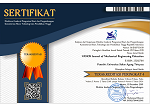PERFORMANCE STUDY OF WOOD CHIPS GASIFICATION STOVE
Abstract
This research aims at investigating the performance of a gasification stove with wood-chips as fuel and recognizing the factors affecting. The stove consisted of a reactor, a char chamber, and a burner. The fuel was fed into the reactor with a certain amount of primary air was flowed through the bottom part of the reactor, and then was ignited from the topside of the fuel. Meanwhile, combustion zone move down and left char that would be taken out after the process finished. Combustible gases resulted from reactions flowed to the burner where the secondary air enters through holes located at burner side combusted the combustible gases. The highest performance achieve was still relatively low (7.3 %), so that model design improvement is required. The stove performance could be possibly influenced by the following parameters, namely: combustion zone propagation rate, fuel consumption rate, and specific gasification rate, which all of them were very interrelated and indicated temperature stability that was proportional to the efficiency achieved. These were shown by stable water temperature profile obtained from boiling process during gasification. The more stable the process the higher the efficiency.
Keywords
Full Text:
PDFReferences
Ayoub, J. and Brunet, E. (1996) ‘Performance of large portable metal woodstoves for community kitchens’, Renewable Energy, 7(1), pp. 71–80.
Belonio, A. T. (2005) Rice Husk Gas Stove Handbook. Apropriate Technology Center, College of Agriculture, Central Philippine University, Iloilo City, Philippines.
Berrueta, V. M., Edwards, R. D. and Masera, O. R. (2008) ‘Energy performance of wood-burning cookstoves in Michoacan, Mexico’, Renewable Energy, 33(5), pp. 859–870. doi: 10.1016/j.renene.2007.04.016.
Breault, R. W. (2010) ‘Gasification processes old and new: A basic review of the major technologies’, Energies, 3(2), pp. 216–240. doi: 10.3390/en3020216.
IEA (2019) World Energy Prices. Paris, France. Available at: https://www.iea.org/statistics/prices/.
Kornelius, G. et al. (2013) ‘A wood gasification stove for domestic use : performance and emission factors using locally available fuel’, Clean Air Journal = Tydskrif vir Skoon Lug, 23(1), pp. 32–35. doi: 10.13140/2.1.2616.5449.
Kumar, A., Jones, D. D. and Hanna, M. A. (2009) ‘Thermochemical biomass gasification: A review of the current status of the technology’, Energies, 2(3), pp. 556–581. doi: 10.3390/en20300556.
McKendry, P. (2002) ‘Energy production from biomass (part 3): gasification technologies’, Bioresource Technology, 83, pp. 55–63. doi: https://doi.org/10.1016/S0960-8524(01)00120-1.
Nwakaire, J. N. and Ugwuishiwu, B. O. (2015) ‘Development of a Natural Cross Draft Gasifier Stove for Application in Rural Communities in Sub-Saharan Africa’, Journal of Applied Sciences. Science Alert, 15(9), pp. 1149–1157. doi: 10.3923/jas.2015.1149.1157.
Panwar, N. L., Kaushik, S. C. and Kothari, S. (2011) ‘Role of renewable energy sources in environmental protection: A review’, Renewable and Sustainable Energy Reviews, 15(3), pp. 1513–1524. doi: 10.1016/j.rser.2010.11.037.
Panwar, N. L. and Rathore, N. S. (2008) ‘Design and performance evaluation of a 5 kW producer gas stove’, Biomass and Bioenergy, 32(12), pp. 1349–1352. doi: 10.1016/j.biombioe.2008.04.007.
PR, F. et al. (2017) ‘Designing a Cooker to Utilise the Natural Waste Rice Husk as a Cooking Gas’, Advances in Recycling & Waste Management, 01(03). doi: 10.4172/2475-7675.1000117.
Ramírez, J. J., Martínez, J. D. and Petro, S. L. (2007) ‘Basic design of a fluidized bed gasifier for rice husk on a pilot scale’, Latin American Applied Research, 37(4), pp. 299–306.
Situmorang, Y. A. et al. (2020) ‘Small-scale biomass gasification systems for power generation (<200 kW class): A review’, Renewable and Sustainable Energy Reviews, 117(October 2019), p. 109486. doi: 10.1016/j.rser.2019.109486.
Sutar, K. B. et al. (2015) ‘Biomass cookstoves: A review of technical aspects’, Renewable and Sustainable Energy Reviews, 41, pp. 1128–1166. doi: 10.1016/j.rser.2014.09.003.
Suvarnakuta, P. and Suwannakuta, P. (2006) ‘Biomass Cooking Stove for Sustainable Energy and Environment’, in The 2nd Joint International Conference on “Sustainable Energy and Environment (SEE 2006)”. Bangkok, Thailand, pp. 1–5.
DOI: http://dx.doi.org/10.30870/vanos.v4i2.6730
Refbacks
- There are currently no refbacks.

This work is licensed under a Creative Commons Attribution 4.0 International License.


.png)
.png)
